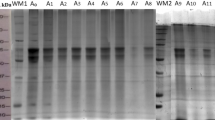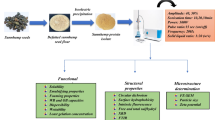Abstract
Ultrasound is one of the non-thermal, green, and novel technologies used to functionalize plant proteins. We recently determined the optimum conditions of high-intensity ultrasound (HIUS) treatment for maximum solubility and investigated the functional properties of hemp seed protein isolate (HSPI) under the optimal conditions. In this study, we analyzed changes in primary, secondary, and tertiary structures, physical microstructures, thermal stability, and antioxidant capacity of ultrasound-applied hemp protein isolate (HSPI-HIUS). The free SH group content (+59%) and zeta potential (+25%) increased upon ultrasound treatment. The electrophoretic protein patterns of HSPI showed no significant change after HIUS treatment. The FTIR spectrum revealed the wavenumber shifts in Amid 1 and 2 regions of protein. The denaturation temperature and the ratio of β-structure increased after sonication. Antioxidant properties of hemp seed protein isolates were increased by 38% by ultrasound treatment. The obtained data in this study showed that HIUS treatment would be promising for improving the functional, physicochemical, and antioxidant properties of HSPI.
Graphical abstract



Similar content being viewed by others
Data Availability
All data generated or analyzed during this study are included in this published article and its supplementary information files.
References
Sun-Waterhouse D, Zhao M, Waterhouse GI (2014) Protein modification during ingredient preparation and food processing: approaches to improve food processability and nutrition. Food Bioproc Tech 7:1853–1893. https://doi.org/10.1007/s11947-014-1326-6
Moreno-Gonzalez M, Ottens M (2021) A structured approach to recover valuable compounds from agri-food side streams. Food Bioproc Tech 14:1387–1406. https://doi.org/10.1007/s11947-021-02647-6
Credence Research (2022) Hemp oil market. https://www.credenceresearch.com/report/hemp-oil-market. Accessed 15 May 2022
Shen P, Gao Z, Xu M, Ohm JB, Rao J, Chen B (2020) The impact of hempseed dehulling on chemical composition, structure properties and aromatic profile of hemp protein isolate. Food Hydrocoll 106:105889. https://doi.org/10.1016/j.foodhyd.2020.105889
Schluttenhofer C, Yuan L (2017) Challenges towards revitalizing hemp: a multifaceted crop. Trends Plant Sci 22:917–929. https://doi.org/10.1016/j.tplants.2017.08.004
Setti, L, Samaei, SP, Maggiore, I, Nissen, L, Gianotti, A, Babini, E (2020) Comparing the effectiveness of three different biorefinery processes at recovering bioactive products from hemp (Cannabis sativa L.) byproduct. Food Bioprocess Technol 13(12):2156-2171. https://doi.org/10.1007/s11947-020-02550-6
Pang, XH, Yang, Y, Bian, X et al (2021) Hemp (Cannabis sativa L.) seed protein–EGCG conjugates: covalent bonding and functional research. Foods 10(7):1618. https://doi.org/10.3390/foods10071618
Yin SW, Tang CH, Cao JS, Hu EK, Wen QB, Yang XQ (2008) Effects of limited enzymatic hydrolysis with trypsin on the functional properties of hemp (Cannabis sativa L.) protein isolate. Food Chem 106:1004–1013. https://doi.org/10.1016/j.foodchem.2007.07.030
Karabulut G, Yemiş O (2022) Modification of hemp seed protein isolate (Cannabis sativa L.) by high-intensity ultrasound treatment. Part 1: Functional properties. Food Chem 375:131843. https://doi.org/10.1016/j.foodchem.2021.131843
Jiang L, Wang J, Li Y, Wang Z, Liang J, Wang R, Chen Y, Ma W, Qi B, Zhang M (2014) Effects of ultrasound on the structure and physical properties of black bean protein isolates. Food Res Int 62:595–601. https://doi.org/10.1016/j.foodres.2014.04.022
Wang S, Wang J, Xue F, Li C (2019) Effects of heating or ultrasound treatment on the enzymolysis and the structure characterization of hempseed protein isolates. J Food Sci Technol 56:3337–3346. https://doi.org/10.1007/s13197-019-03815-5
Nazari B, Mohammadifar MA, Shojaee-Aliabadi S, Feizollahi E, Mirmoghtadaie L (2018) Effect of ultrasound treatments on functional properties and structure of millet protein concentrate. Ultrason Sonochem 41:382–388. https://doi.org/10.1016/j.ultsonch.2017.10.002
Jiang S, Ding J, Andrade J, Rababah TM, Almajwal A, Abulmeaty MM, Feng H (2017) Modifying the physicochemical properties of pea protein by pH-shifting and ultrasound combined treatments. Ultrason Sonochem 38:835–842. https://doi.org/10.1016/j.ultsonch.2017.03.046
Li S, Yang X, Zhang Y, Ma H, Liang Q, Qu W, Mahunu GK (2016) Effects of ultrasound and ultrasound assisted alkaline pretreatments on the enzymolysis and structural characteristics of rice protein. Ultrason Sonochem 31:20–28. https://doi.org/10.1111/jfpe.12377
Li K, Ma H, Li S, Zhang C, Dai C (2017) Effect of ultrasound on alkali extraction protein from rice dreg flour. J. Food Process Eng 40:12377. https://doi.org/10.1016/j.ultsonch.2015.11.019
Hadnađev M, Dapčević-Hadnađev T, Lazaridou A, Moschakis T, Michaelidou AM, Popović S, Biliaderis CG (2018) Hempseed meal protein isolates prepared by different isolation techniques. Part I. physicochemical properties. Food Hydrocoll 79:526–533. https://doi.org/10.1016/j.foodhyd.2017.12.015
Sadat A, Joye IJ (2020) Peak fitting applied to fourier transform infrared and raman spectroscopic analysis of proteins. Appl Sci 10(17):5918. https://doi.org/10.3390/app10175918
Stefanović AB, Jovanović JR, Dojčinović MB, Lević SM, Nedović VA, Bugarski BM, Knežević-Jugović ZD (2017) Effect of the controlled high-intensity ultrasound on improving functionality and structural changes of egg white proteins. Food Bioprocess Technol 10(7):1224–1239. https://doi.org/10.1007/s11947-017-1884-5
Greenfield NJ (2007) Analysis of the kinetics of folding of proteins and peptides using circular dichroism. Nat 1:2891–2899. https://doi.org/10.1038/nprot.2006.244
Zhu Z, Zhu W, Yi J, Liu N, Cao Y, Lu J, Decker EA, McClements DJ (2018) Effects of sonication on the physicochemical and functional properties of walnut protein isolate. Food Res Int 106:853–861. https://doi.org/10.1016/j.foodres.2018.01.060
Hu H, Wu J, Li-Chan ECY, Zhu L, Zhang F, Xu X, Fan G, Wang L, Huang X, Pan S (2013) Effects of ultrasound on structural and physical properties of soy protein isolate (SPI) dispersions. Food Hydrocoll 30:647–655. https://doi.org/10.1016/j.foodhyd.2012.08.001
Tang CH, Ten Z, Wang XS, Yang XQ (2006) Physicochemical and functional properties of hemp (Cannabis sativa L.) protein isolate. J Agric Food Chem 54:8945–8950. https://doi.org/10.1021/jf0619176
Malik MA, Sharma HK, Saini CS (2017) High intensity ultrasound treatment of protein isolate extracted from dephenolized sunflower meal: effect on physicochemical and functional properties. Ultrason Sonochem 39:511–519
Yildiz G, Andrade J, Engeseth NE, Feng H (2017) Functionalizing soy protein nano-aggregates with pH-shifting and mano-thermo-sonication. J Colloid Interface Sci 505:836–846. https://doi.org/10.1016/j.jcis.2017.06.088
Arzeni C, Martínez K, Zema P, Arias A, Pérez OE, Pilosof AMR (2012) Comparative study of high intensity ultrasound effects on food proteins functionality. J Food Eng 108:463–472. https://doi.org/10.1016/j.jfoodeng.2011.08.018
Resendiz-Vazquez JA, Ulloa JA, Urías-Silvas JE, Bautista-Rosales PU, Ramírez-Ramírez JC, Rosas-Ulloa P, González-Torres L (2017) Effect of high-intensity ultrasound on the technofunctional properties and structure of jackfruit (Artocarpus heterophyllus) seed protein isolate. Ultrason Sonochem 37:436–444. https://doi.org/10.1016/j.ultsonch.2017.01.042
Vera A, Valenzuela A, Yazdani-Pedram M, Tapia C, Abugoch L (2019) Conformational and physicochemical properties of quinoa proteins affected by different conditions of high-intensity ultrasound treatments. Ultrason Sonochem 51:186–196. https://doi.org/10.1016/j.ultsonch.2018.10.026
Falcão HG, Silva MBR, de Camargo AC, Shahidi F, Franchin M, Rosalen PL, Alencar SM, Kurozawa LE, Ida EI (2019) Optimizing the potential bioactivity of isoflavones from soybeans via ultrasound pretreatment: antioxidant potential and NF-κB activation. J Food Biochem 43(11):13018. https://doi.org/10.1111/jfbc.13018
Acknowledgments
This study was the second part of Mrs. Karabulut’s Ph. D. thesis. The authors would also like to acknowledge the valuable help of Yavuz Derin during FTIR analysis.
Funding
This work was supported by the Commission of Scientific Research Projects of Sakarya University (Sakarya, Turkey) [Grant Number 2020–7–25–24].
Author information
Authors and Affiliations
Contributions
Gulsah KARABULUT: Methodology, Writing-Original draft, Formal analysis. Hao FENG: Reviewing, Editing. Oktay YEMİŞ: Funding Acquisition, Supervision, Critical Reviewing-Editing.
Corresponding author
Ethics declarations
Competing interests
The authors declare no competing interests.
Ethics Approval and Consent to Participate
Not applicable.
Consent for Publication
Not applicable.
Conflict of Interest
The authors declare no conflict of interest.
Additional information
Publisher's Note
Springer Nature remains neutral with regard to jurisdictional claims in published maps and institutional affiliations.
Supplementary Information
Below is the link to the electronic supplementary material.
Rights and permissions
Springer Nature or its licensor holds exclusive rights to this article under a publishing agreement with the author(s) or other rightsholder(s); author self-archiving of the accepted manuscript version of this article is solely governed by the terms of such publishing agreement and applicable law.
About this article
Cite this article
Karabulut, G., Feng, H. & Yemiş, O. Physicochemical and Antioxidant Properties of Industrial Hemp Seed Protein Isolate Treated by High-Intensity Ultrasound. Plant Foods Hum Nutr 77, 577–583 (2022). https://doi.org/10.1007/s11130-022-01017-7
Accepted:
Published:
Issue Date:
DOI: https://doi.org/10.1007/s11130-022-01017-7




